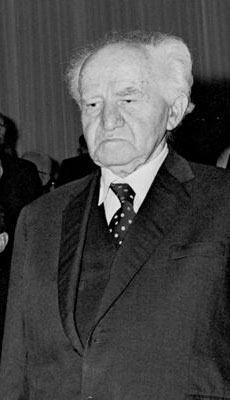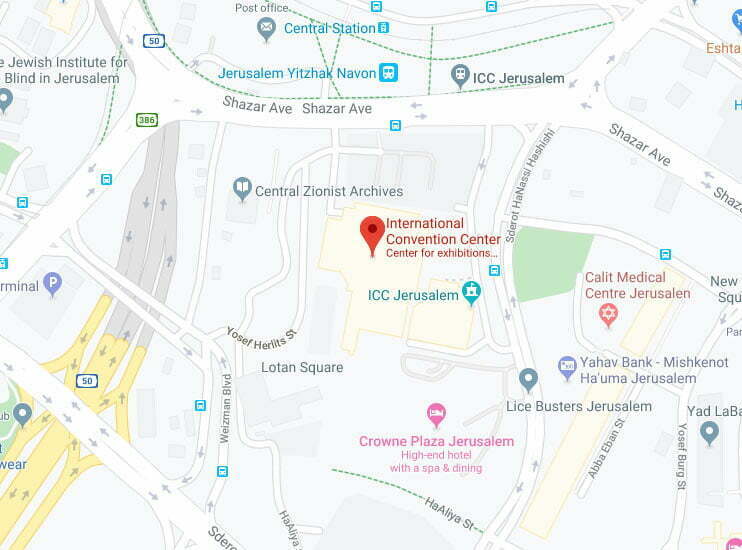The History of ICC Jerusalem
Born for Greatness
The International Convention Center in Jerusalem, or Binyanei Ha’uma (Hebrew: the Nation’s Buildings) as it was originally named, was established in 1950 as part of a plan for a government campus in nearby Givat Ram in Jerusalem. ICC Jerusalem was founded by the Jewish Agency, the Jewish National Fund, and the Jerusalem Economic Development Company, which joined forces in building a conference center that would symbolize the sovereignty of the young State of Israel and become a gathering point for the Jewish people.
ICC Jerusalem was planned to be the official seat of the Zionist Congress, which since its establishment roamed among various European cities in the lack of a permanent residence. Indeed, even before construction was completed, the 23rd Zionist Congress convened at ICC Jerusalem, the first to be held in the State of Israel.
The founders of ICC Jerusalem designated the building for greatness: it was to be designed as a center for international conferences and congresses, art exhibitions and assemblies of science and wisdom. They sought to illustrate to the citizens of Israel, the Jews of the Diaspora and the nations of the world the role that Jerusalem fulfills in Jewish life and the contribution of the Jewish people to the global civilization and culture.
To this day, more than 65 years later, the International Convention Center in Jerusalem is considered as the most important and reputable conference center in Israel. The International Convention Center continues to be the home of the Zionist Congress with international and national conferences and cultural and arts events taking place there as foreseen by its proponents.
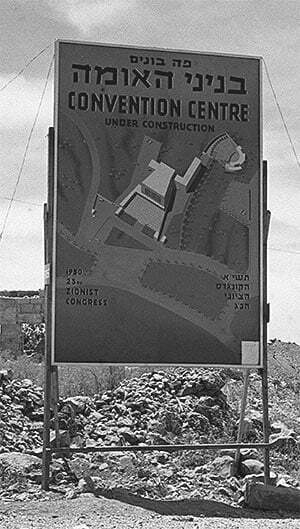
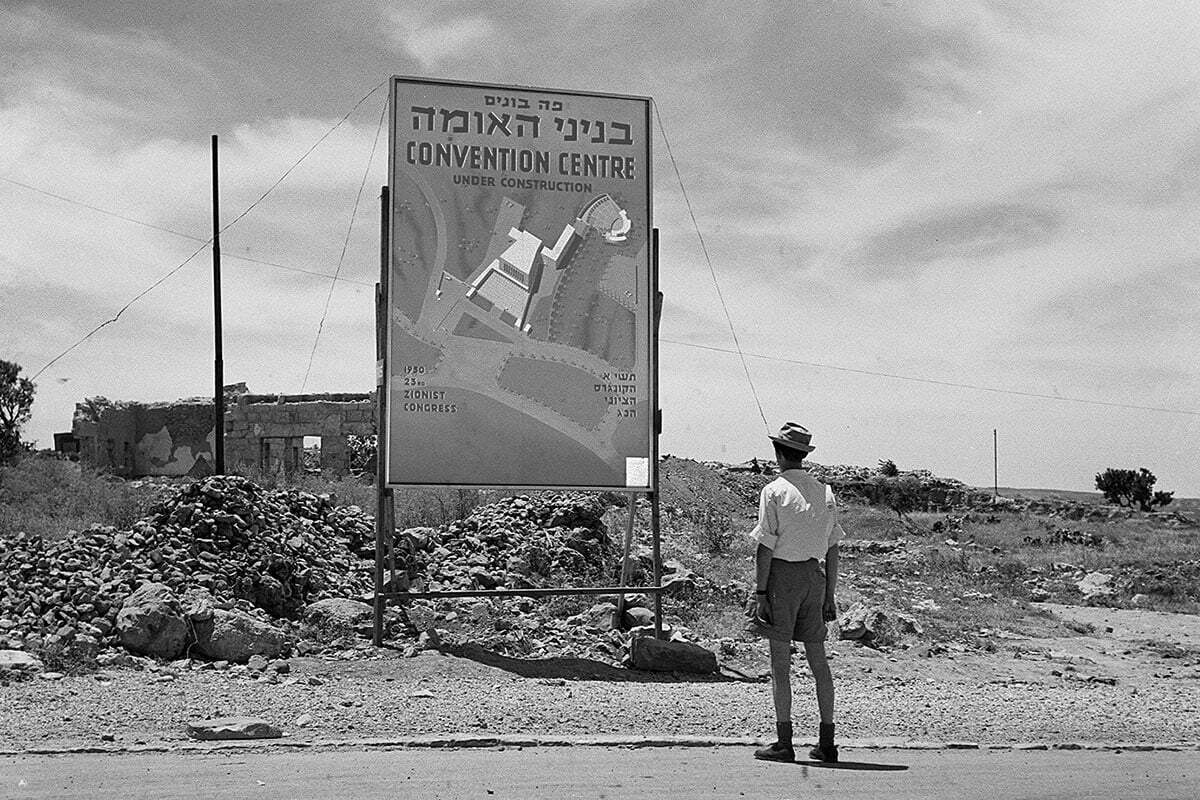
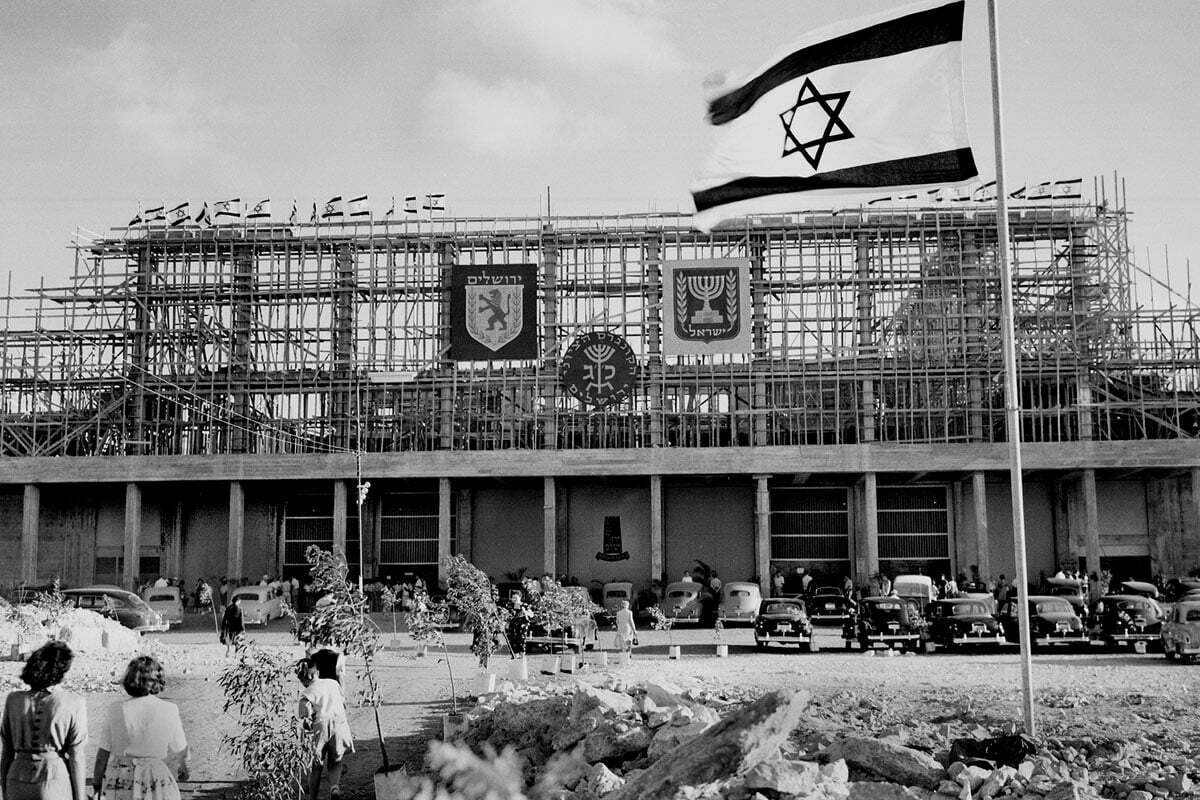
The Construction of ICC Jerusalem
With the closing of the First Zionist Congress in Basel, Herzl dreamed of establishing a permanent home for the Congress in Jerusalem. In his book “Alteneuland” (1902), he described it as a monumental building with luminous marble, tall and spacious, where Congress delegates walk in its halls.
In 1949, Alexander (Ezer) Yevzarov of the Jewish Agency, an energetic visionary with the rare ability to make things happen, approached Prime Minister David Ben Gurion and proposed that he establish a conference center in Jerusalem that would serve as a place for conventions and celebratory events. Ben Gurion felt that this conference center should be given a Hebrew name, and gave his approval to hold an architectural competition. Architect Zeev Rechter of his firm Rechter Zarchi Rechter won the competition. Seven months later, blasting of the rocks began at the building site where the village Sheikh Bader once stood.
The date for completion of the building, with its name determined as “Binyanei Ha’uma”, was set for the opening of the 23rd Zionist Congress in 1951. In order to expedite the work, a dedicated Company was established with the goal of building a compound of versatile buildings that would make Jerusalem an international cultural center. Yevzarov was appointed as the company’s manager. Even though the founders did not have full funding to complete the building on time, the works began with the hope that the shortfall would be raised.
Despite enormous efforts, the building was not completed before the opening of the 23rd Zionist Congress. Nevertheless, the largest hall, the Ussishkin Hall, was still able to host the first Zionist Congress to be held in the State of Israel. Raising money to complete construction of the building was not an easy matter. Yevzarov raised funds from the Jewish organizations, issued preferred shares and took loans from local insurance companies, but these sources were still not enough.
Consequently, membership shares were issued to the public, each worth 10 Lirot, which entitled their holders’ tickets for future performances and prizes, which included trips to cultural sites abroad. The construction work was finally completed only in 1959.
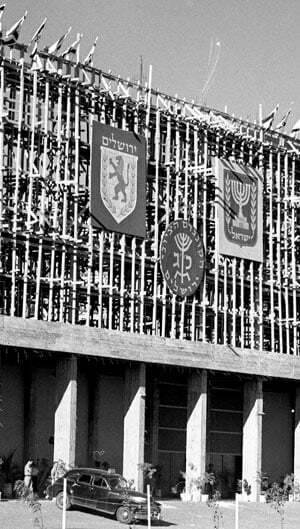
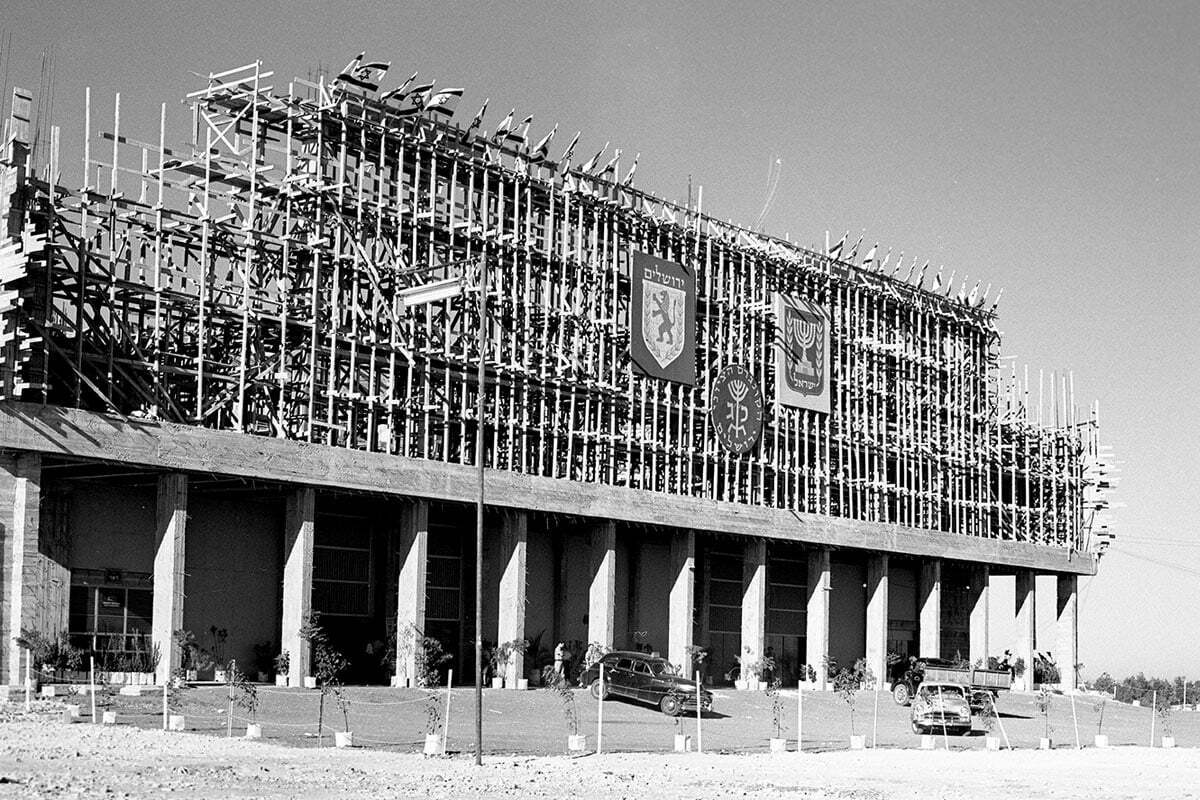
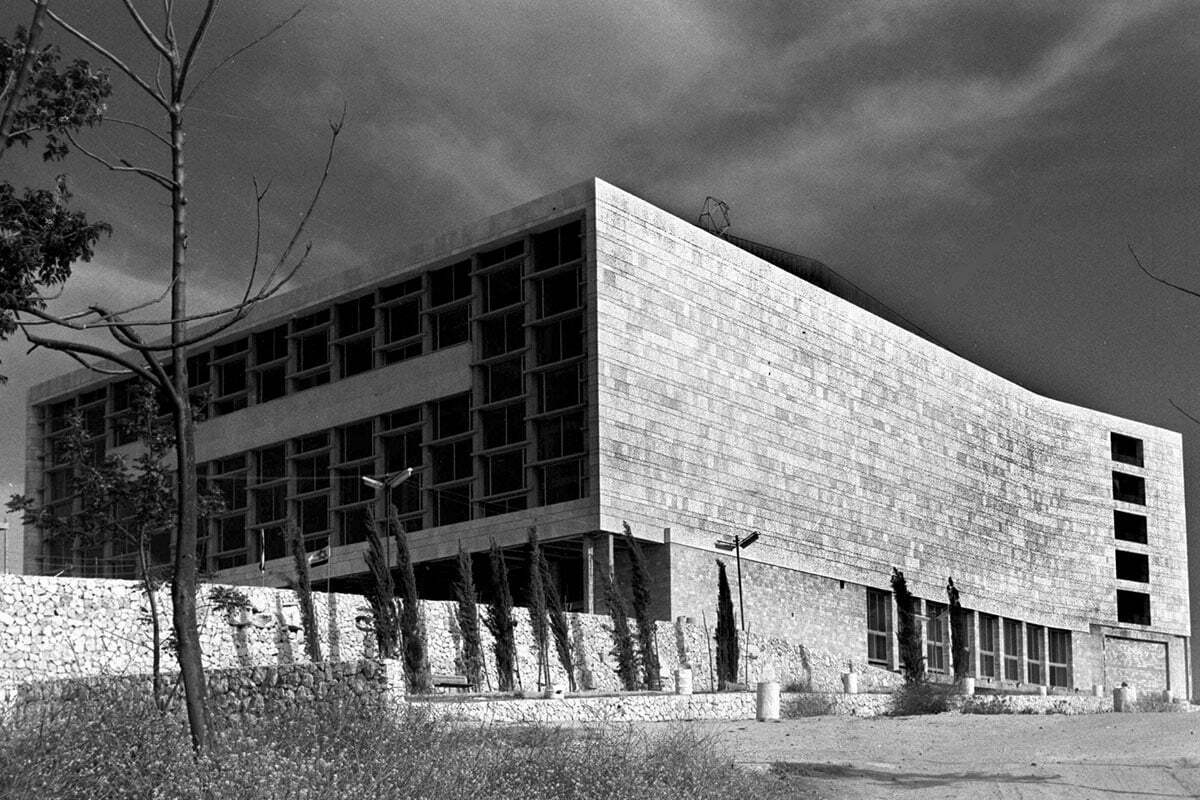
The Permanent home of the Zionist Congress
54 years after Benjamin Zeev Herzl declared “In Basel, I founded the state of the Jews”, the 23rd Zionist Congress convened at Binyanei Ha’uma in Jerusalem, it’s permanent home from that time on. Piles of earth were moved from place to place, an entrance plaza was leveled and flattened, access ways were paved and electricity and telephone lines were installed. Hundreds of people worked day and night to prepare the Great Hall for the congress-goers. Thus, within the unfinished frame of the building, the scaffolding and the steel bars, a stately backdrop was prepared, made of cloth and cardboard. the floor was laid with blue carpets and 1,900 seats were installed. The Congress convened on August 14, 1951, with 450 delegates present and more than 1,500 participants from all over the world.
Jerusalem could not accommodate all the visitors’ congress. Even though 500 hotel rooms, public institutions, and boardinghouses were recruited, it was still not enough. Jerusalem residents were called on to lodge congress guests at their private homes. The festive congress was opened during a period of austerity – the commissary that was established to feed the congress was given a special allocation of basic commodities. The deliberations of the First Zionist Congress in the Land of Israel led to three important decisions: the creation of the State of Israel, the ingathering of the Diaspora into the Land of Israel and ensuring the unity of the Jewish people. Since no one filled the role of president of the congress that year, David Ben-Gurion served as Chairman of the Zionist Executive. Since then, Nahum Goldman, Arye Dulchin, Simcha Dinitz, Avraham Burg, Sallai Meridor and Zeev Bielski are among those who have served as Presidents of the Zionist Congress.
Ever since, the International Convention Center has been hosting the Zionist congresses and its delegates from throughout the world, exactly as Benjamin Zeev Herzl foresaw in Basel.
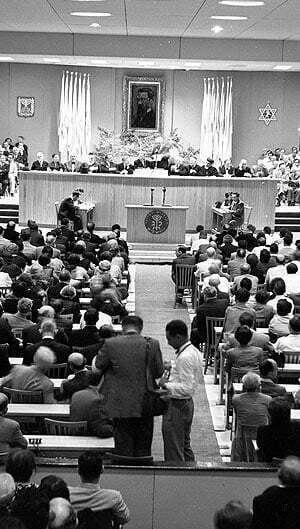
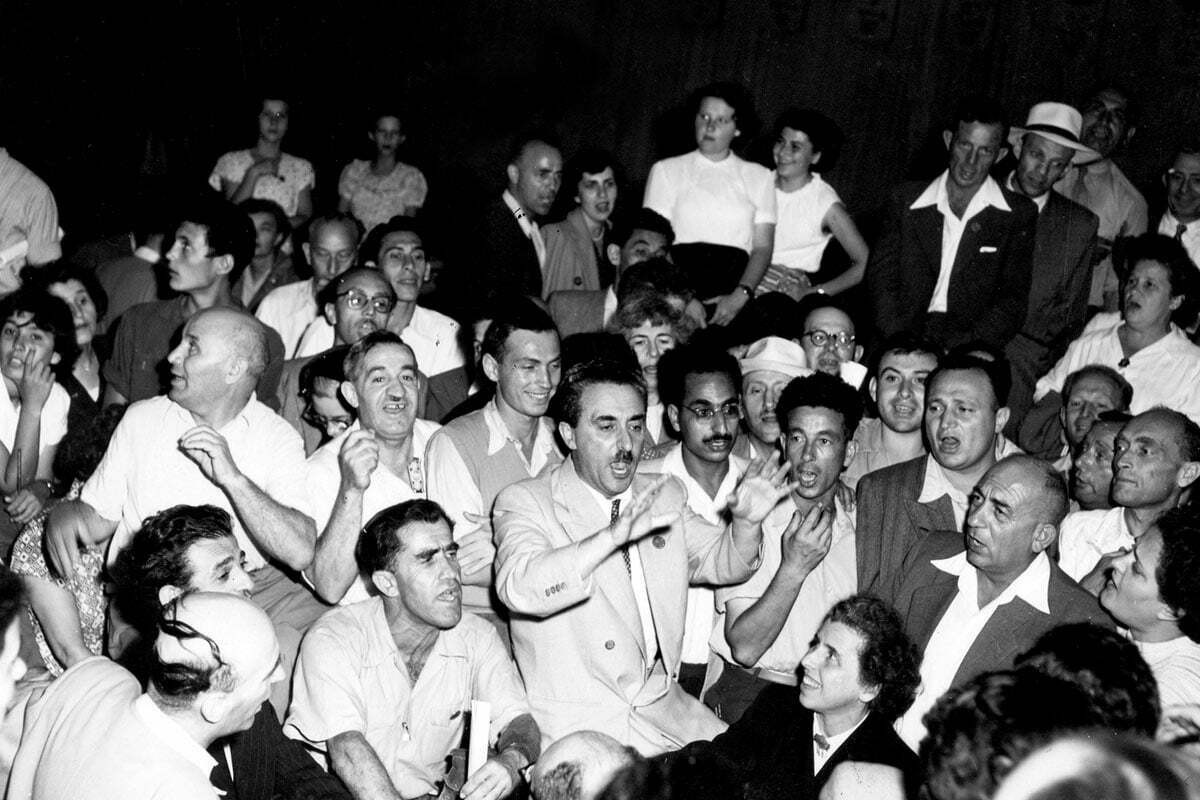
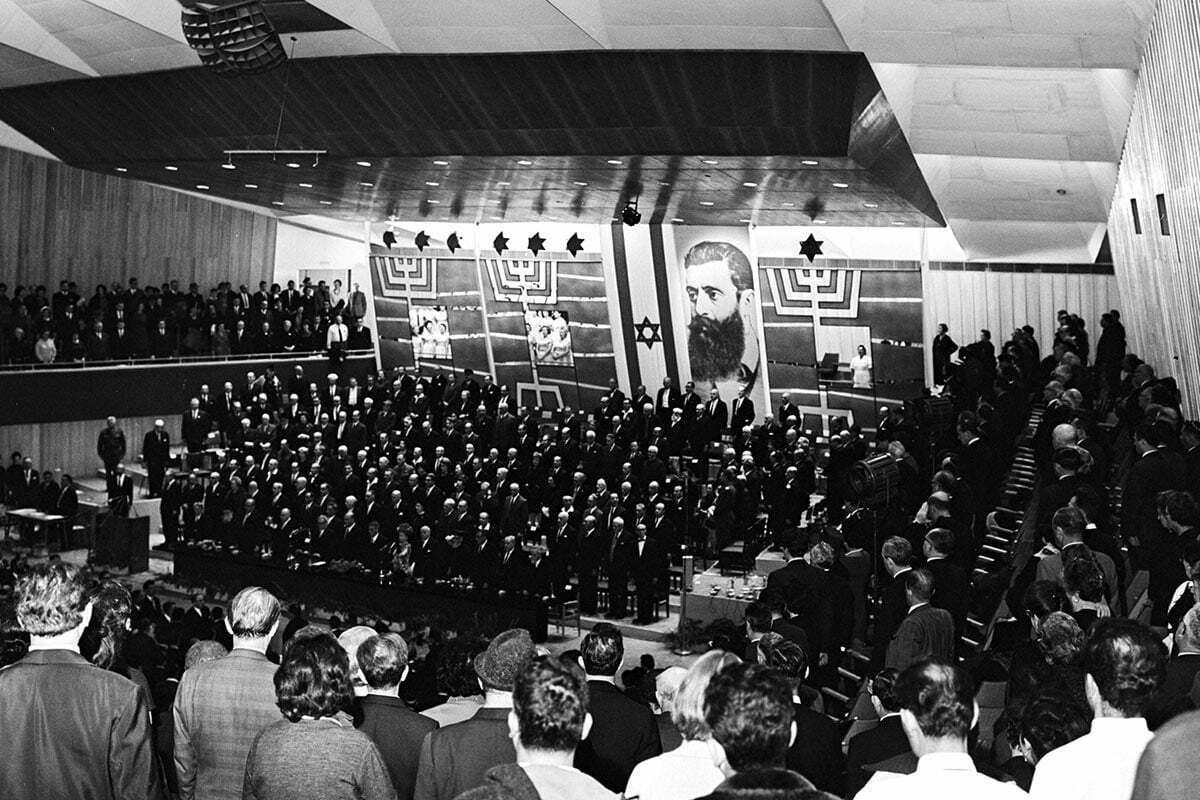
The building and its design
In 1949, Zeev Rechter of the firm Rechter Zarchi Rechter won the competition for the design of Binyanei Ha’uma. Zeev Rechter and his partners in the firm – his son Yacov Rechter and his son-in-law Moshe Zarchi – together designed the monumental structure in a modern and restrained style as a single block with a commanding facade, appearing like a cliffside rising upward.
As a symbol of the establishment of the Jewish state in the Land of Israel after 2,000 years of exile, the building was clad with local stone like the ones of the hills around it. The design was in the architectural spirit that characterized international public buildings of its time such as the Royal Festival Hall in London and the United Nations building in New York. A monumental wall relief was planned for the facade designed by artists Yosef Zaritzky and Yitzhak Danziger but was not executed in the end. Another plan not executed was the construction of an amphitheater designed by Architect Leopold Krakauer.
A spacious plaza was constructed at the entrance of the building, creating a gradual transition between the street and building and evoking a sense of pilgrimage. Not incidentally, the early publications of the Binyanei Ha’uma Association likened the building to the Holy Temple.
In 1988, expansion of the Binyanei Ha’uma complex was placed in the hands of the architectural office of Arthur Spector and Michael Amishav. The octagonal-shaped Teddy Hall, named for Jerusalem’s Mayor Teddy Kollek, was added to the building, built as an eastern entrance structure with a large plaza in front. In the context of its renewal, the historic facade was modified and redesigned with the addition of glass windows.
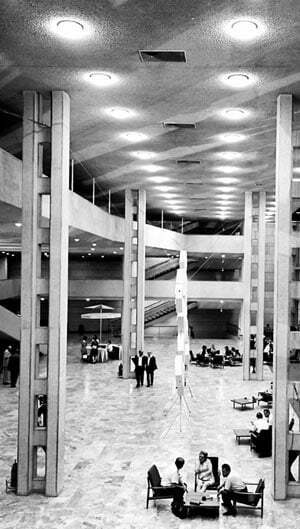
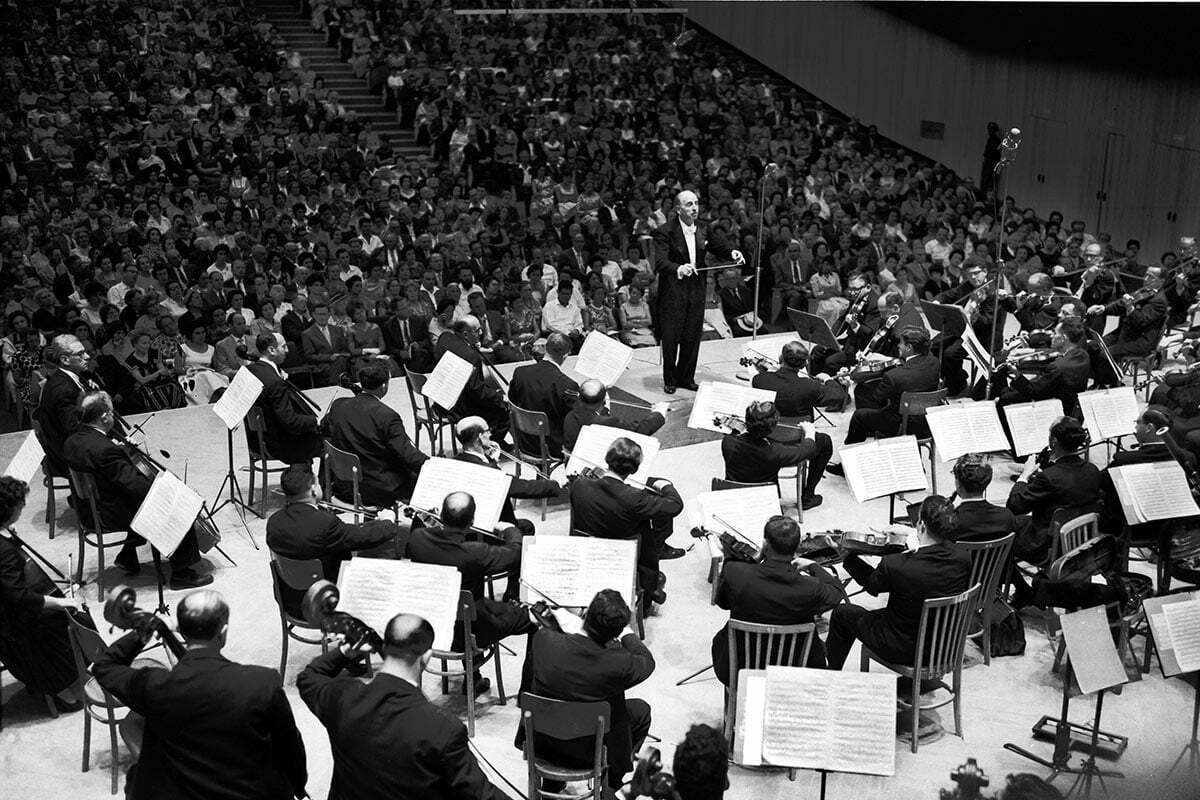
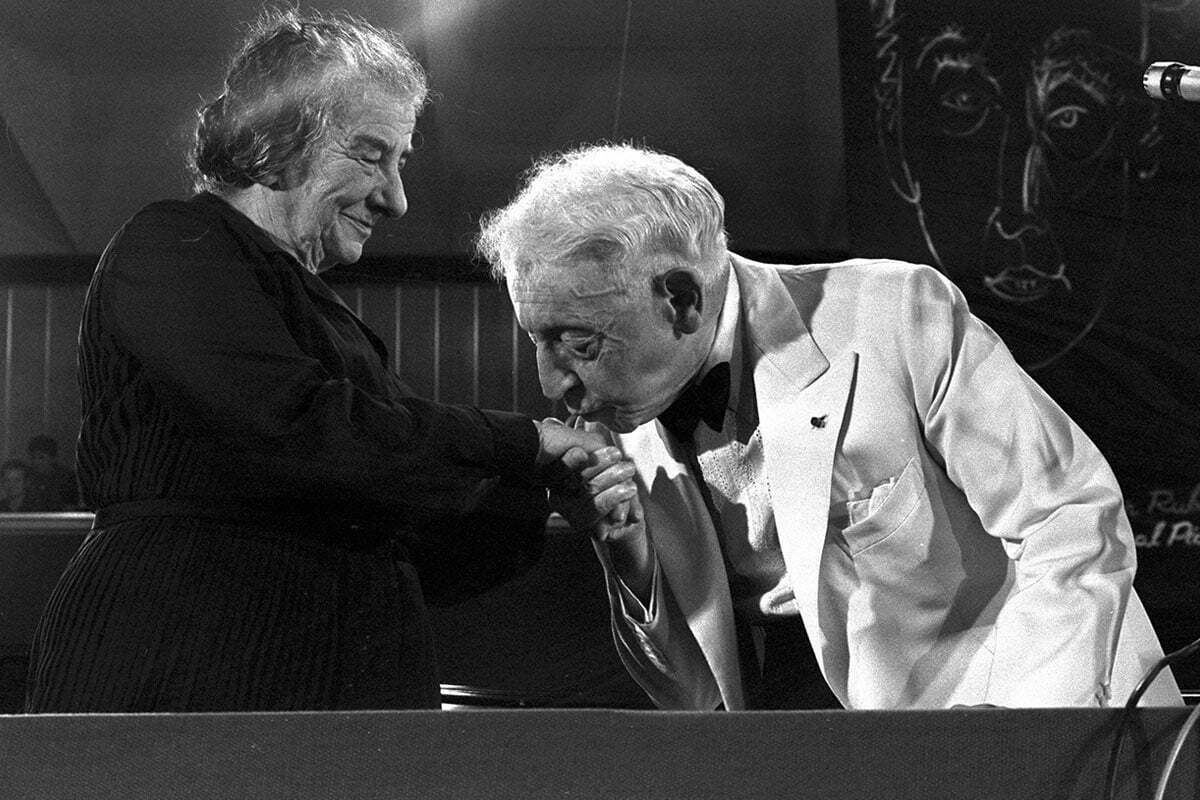
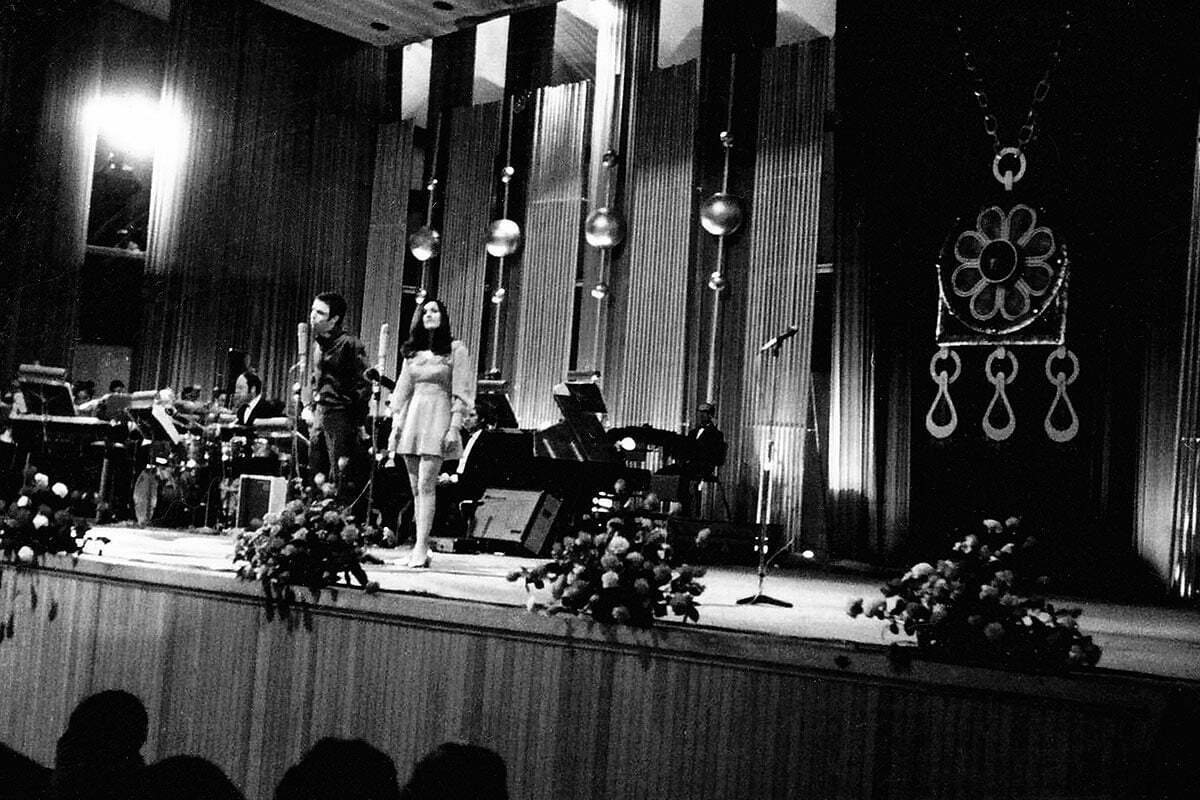
Conquering the Wilderness Exhibition
The International Exhibition “Conquering the Wilderness”, which was opened in 1953, was planned together with the construction of Binyanei Ha’uma so that only two years after its opening, an important international exhibition would already be held in the building. UNESCO, the education, science and cultural organization of the United Nations, aware of the loss of fertile agricultural lands as the result of a lack of skills and negligent utilization of land throughout the world, chose the State of Israel, which sits on the edge of the desert, as the venue for the exhibition. The exhibition was organized by Alexander (Ezer) Yevzarov, the builder and manager of Binyanei Ha’uma.
Technological solutions for sources of water, methods for improving plant varieties and farm animals, advanced agricultural equipment and road-building devices were presented there. Among the countries that participated in the exhibition were Belgium, Finland, Norway, Sweden, Uruguay, Brazil, Argentina, Denmark, the United States, Canada, Turkey, and Greece. More than half a million people visited the exhibition. It was a central event in the life of the country and was seen as a clear Zionist event. Based on the enormous success of the Israeli pavilion at the exhibition, it was decided to make it a permanent exhibition, but was dismantled at the displeasure of many in order to create the “Exhibition of the Decade”.
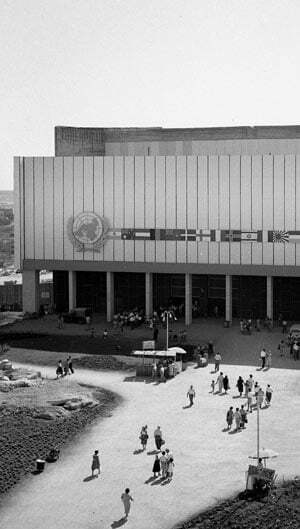
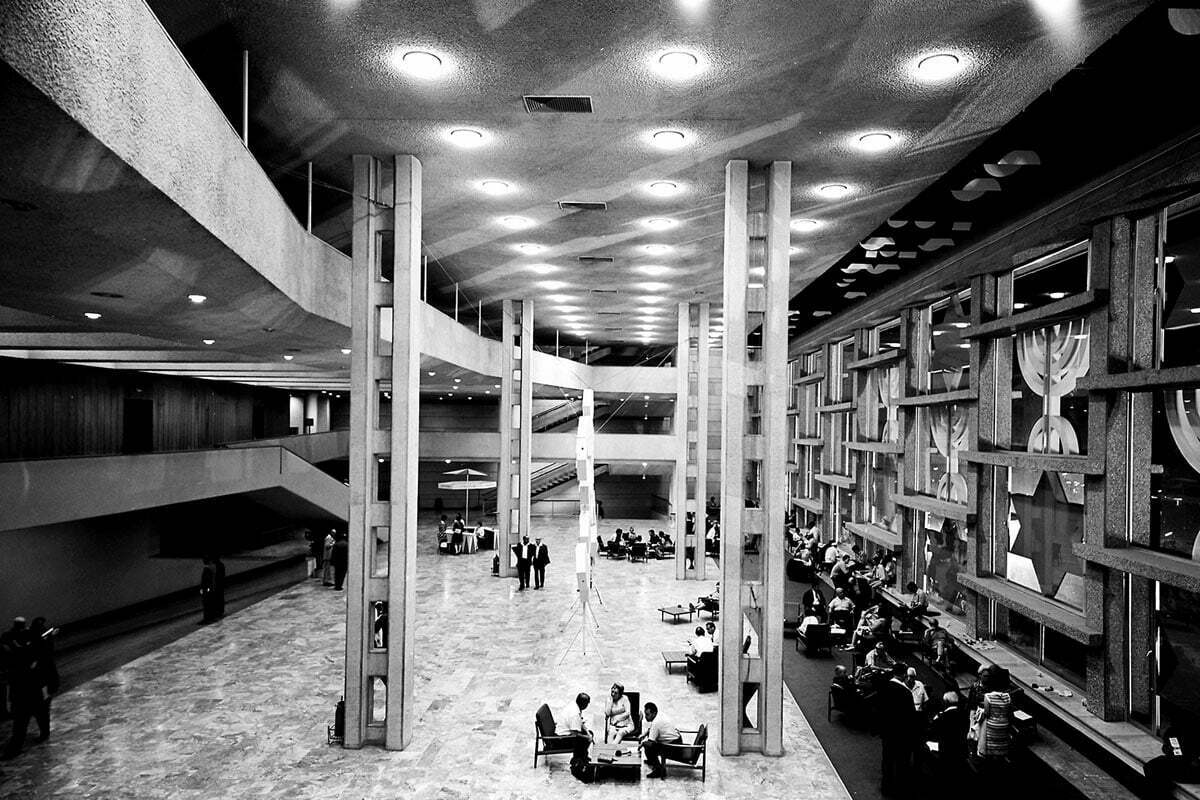
The largest of Israel's exhibitions
The Exhibition of the Decade was the largest ever held up to that point in Israel and took place as part of the state’s 10th-anniversary celebrations. This exhibition was designed to be an educational and public relations enterprise with a target audience that included the citizens of Israel and tourists.
Two main categories made up the exhibition: “the national section”, which was intended to explain the historical background of the People of Israel through the establishment of the state and was divided into several subparts: “The New-Old Nation”, “Immigration Absorption”, “Care for a Healthy People”, “Education, Culture and Art”, “The IDF Pavilion”, “Researching and Utilizing Nature”, “Economic Achievements” and “Looking to the Future” while the second category, “the economic section” was intended to present the achievements of the Israeli economy, and its pavilions were rented to commercial enterprises. This category was also divided into several subparts: “Institutions and Services”, “Tourism, Recreation, Transportation”, “Food, Clothing and Health”, “The Home and Its Contents”, “Machinery and Metal” and “Development Enterprises”. Foreign firms were also represented.
The Exhibition of the Decade was opened on June 5, 1958, and covered an area of 120,000 m². This exhibition provided the pretext for completing the stone cladding on the exterior walls of ICC Jerusalem – Binyanei Ha’uma. The exhibition was opened with a festive event when President Yitzhak Ben Zvi pulled a lever that lit the exhibition grounds. The President and Prime Minister David Ben-Gurion gave speeches and a choral group and orchestra performed Haydn’s oratorio “The Creation”. A broadcast studio for Kol Yisrael radio station was set up at the exhibition, from which quizzes were broadcast directly with the participation of the audience and at which performances were given by the Dudaim, the Nahal Troupe and Arik Einstein, among others. The exhibition was shown for a period of two and a half months, attended by some 600,000 people from all walks of life.
After the exhibition was concluded, it was intended that part of it would remain as a permanent exhibition as was done with the “Conquering the Wilderness” exhibition, but the groups financing the exhibition – Keren Hayesod, the Jewish National Fund, the Government Tourism Company and the Jewish Agency – declined to transfer additional funds for its continued presentation.
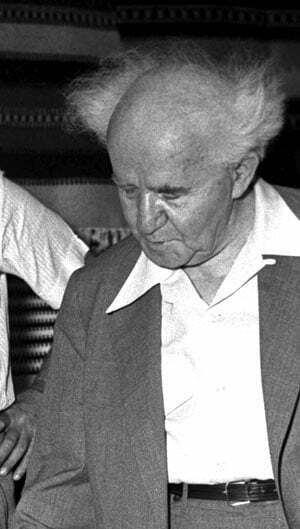
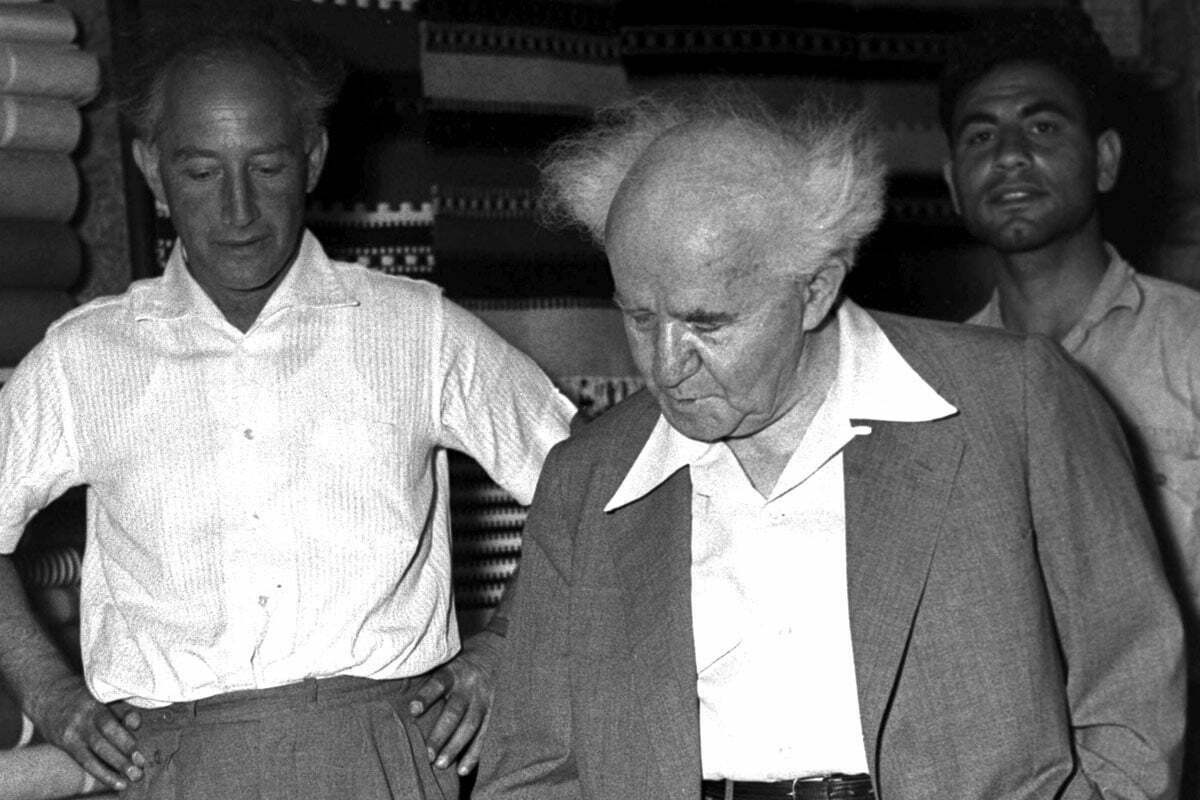
People and events
The first event at ICC Jerusalem was the 23rd Zionist Congress, which was held even before its construction had been completed. Since then, various events and conferences have been held at ICC Jerusalem: concerts, dance and vocal performances, governmental events, political party conventions, international book fair, philately fair, banking conferences, business conferences, events sponsored by the “Taglit” organization and a President’s conference.
Because its many halls are equipped with advanced technologies, the venue has become a natural location for professional conferences and congresses, professional enrichment programs, seminars, study days and other events. The center provides communications services, computerized video conferencing and sophisticated simultaneous translation booths. Its immense spaces can be divided flexibly, enabling the placement of exhibition booths and displays of the highest quality. The congress center has regularly hosted exhibitions and fairs over the last several years such as the Judaica exhibition, the apartment fair, the events fair, the fashion exhibition and the automotive exhibition. The variety of halls, special stages, up-to-date acoustical devices, and sophisticated screens provide an ideal professional backdrop for culture and art shows and events – from the smallest and most intimate to those at a complex international scale. The center professionally and successfully hosts musical performances of every type: operas, symphonies, recitals, ethnic music, rock, jazz, and pop as well as theatrical and dance performances. It serves as the home of the Israel Philharmonic Orchestra in Jerusalem, which holds about 12 concerts each year, as well as the Jerusalem Symphony Orchestra and the Israel Broadcasting Authority. The center has hosted the Eurovision competition twice, and each year presents the events of the Israel Festival as well as the Festigal for children and teenagers. In 2013, ICC Jerusalem hosted the 44th President of the United States Barack Obama, who spoke before thousands of students as part of his historic visit to Israel.
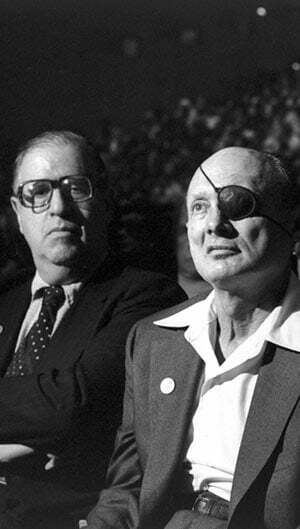
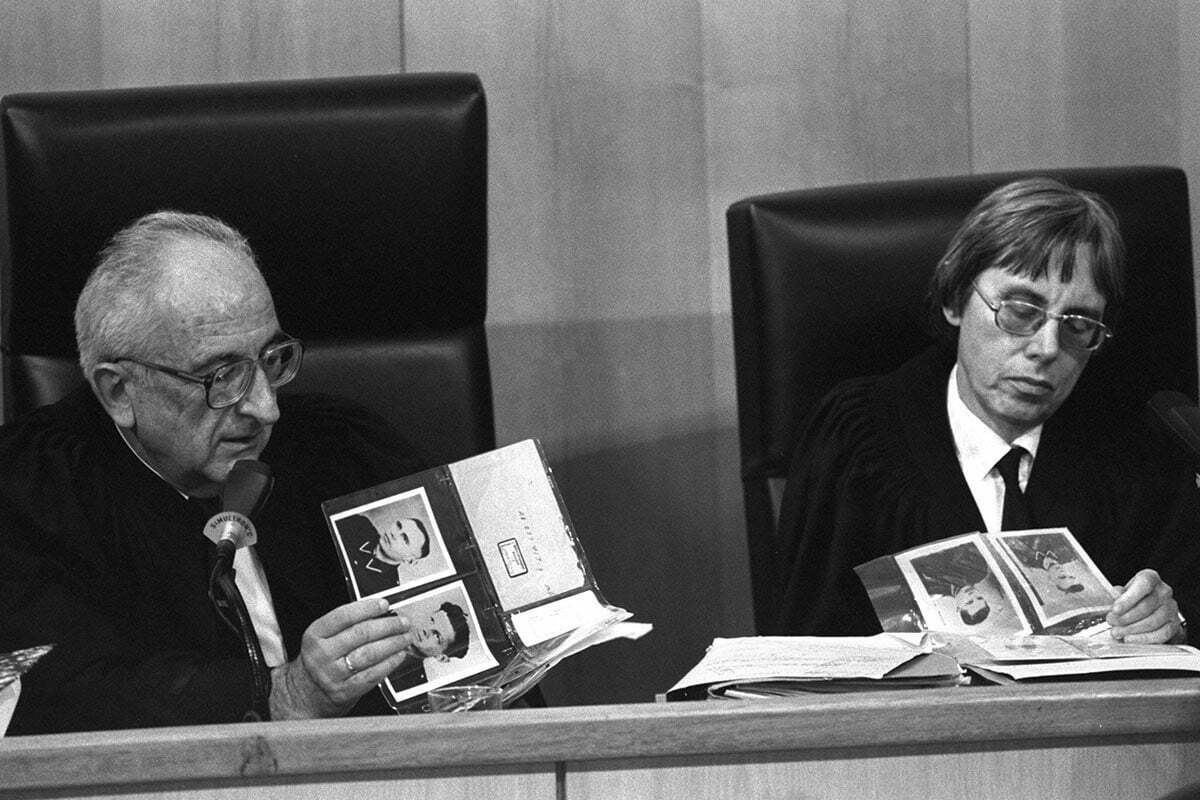
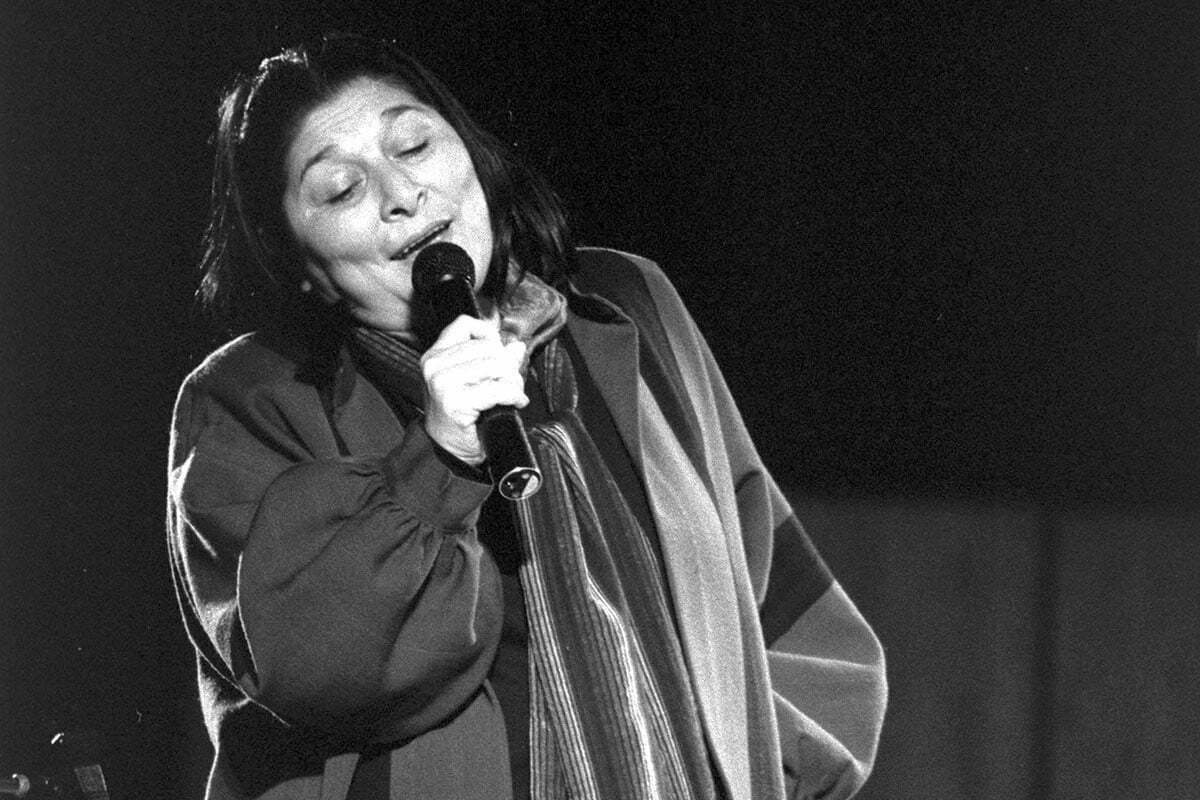
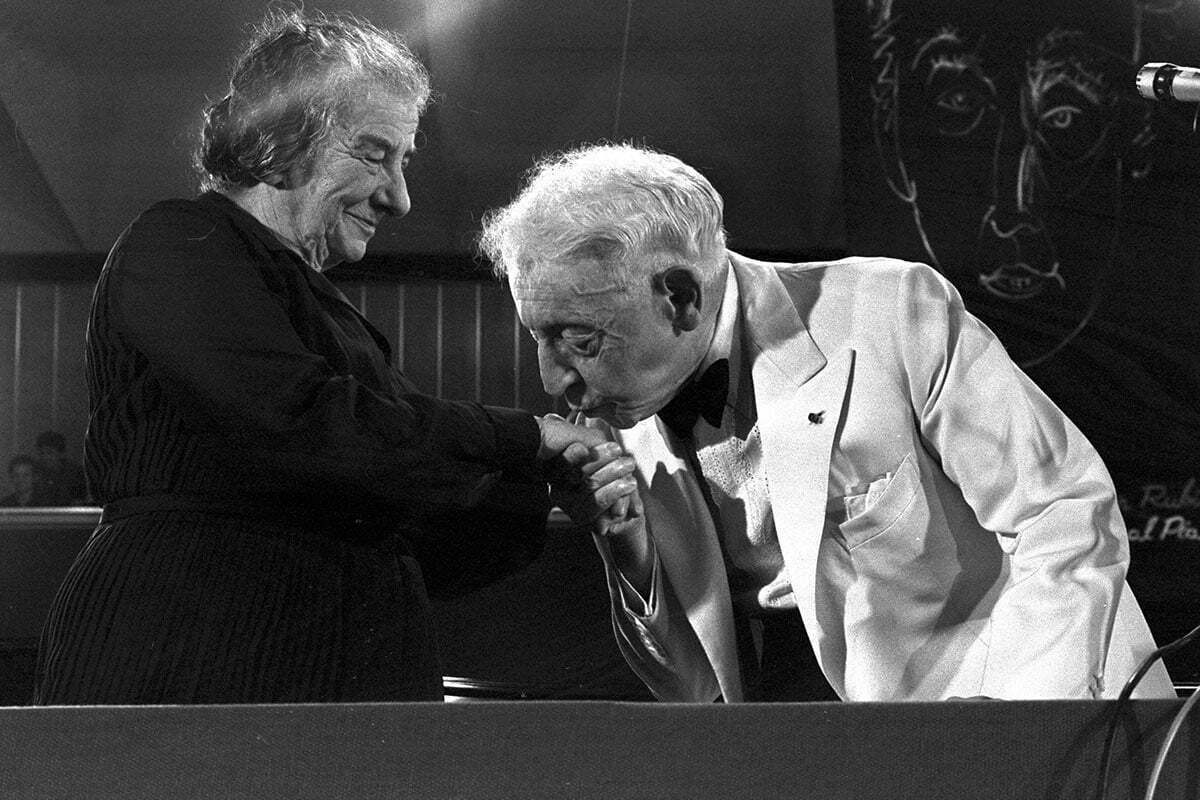
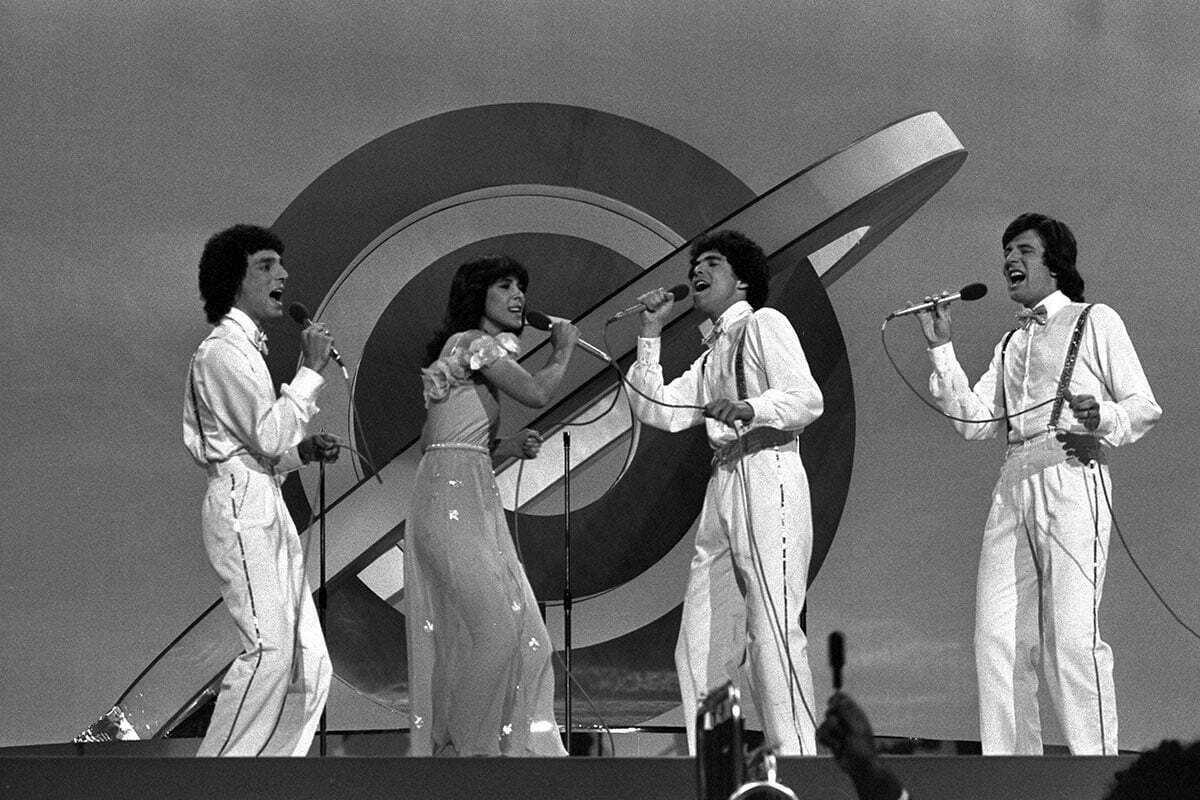
The Israel Song Festival
Long-term cooperation between the Israel Broadcasting Authority and ICC Jerusalem led to one of the Hebrew song events that has become identified with both bodies and has made an indelible mark on the history of Israeli singing and songwriting.
The the Israel Song Festival competition was established in 1960 and was broadcasted on Kol Yisrael radio. The festival moved to ICC Jerusalem in 1965 and was accompanied by the Jerusalem Symphony Orchestra under the direction of Moshe Vilansky. The song “Ayalet Hachen” performed by Arik Einstein and Yaffa Yarkoni won first prize that year. The songs “Hagavia” and “Layla Karev”, performed by the Gesher Hayarkon Trio and Nechama Handel won second and third prizes, respectively. In 1969, the festival was broadcasted on live Television in Israel for the first time.
Among the songs that have been written for the Israel Song Festival and have become inalienable assets in Israeli music are: “Leil Stav” performed by Arik Einstein and Yaffa Yarkoni, “Lo Pa’am Ba’kayitz” performed by Edna Goren and Arik Einstein and “Balada La’hovesh” performed by Yehoram Gaon. The inclusion of this song in the Song Festival during the War of Attrition was accompanied by public criticism and was banned from being played on the radio for a number of years.
In 1967, the Mayor of Jerusalem Teddy Kollek asked for five songs for the festival that were sung outside of the framework of the competition, among them Naomi Shemer’s song “Jerusalem of Gold” performed by Shuli Natan. A few months later, with the outbreak of the Six-Day War, this song became a symbol of the war and of Israel’s victory.
Other songs that were etched into the public consciousness were “Ba’derech Hazara” performed by the soldier Avi Toledano, “Al Kapav Yavi” performed by Rivka Zohar, “Prague” performed by Arik Einstein (who also concluded his appearance at the Song Festival with this song), “Ahavatiha” performed by Shlomo Artzi, “Rabbi Akiva” performed by Rivka Zohar, “Ahavata Shel Teresa Dimone” performed by Ilanit, “Mayim Le’David Hamelech” performed by the Hagashash Hahiver group and many other favorites. The songs of the Israel Song Festival have often become hits during their time and became springboards for the careers of those performing them. Many songs written for the Song Festival have reflected the spirit of their time, referencing central historic events and expressing mainstream mindsets in Israeli society.In 1978 it was decided that the winning song of the festival would represent the State of Israel at the Eurovision competition. Consequently, the nature of the songs in the competition changed, becoming lighter and catchier in order to try to fit the European audience’s tastes. The song “A-Ba-Ni-Bi” performed by Izhar Cohen took first place at the Song Festival and first place at the Eurovision and brought the Eurovision competition of 1979 to ICC Jerusalem. An Israeli song, “Hallelujah”, performed by Gali Atari and the Milk and Honey Group won this competition as well. 20 years later, in 1999, ICC Jerusalem again hosted the Eurovision competition, this time after Dana International won the competition the previous year with the song “Diva”.
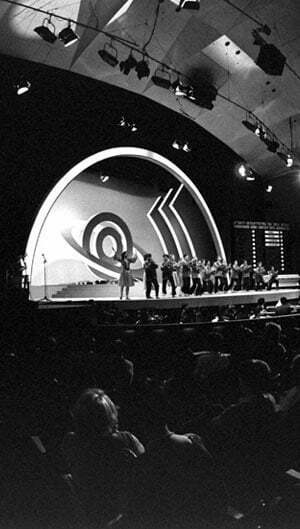
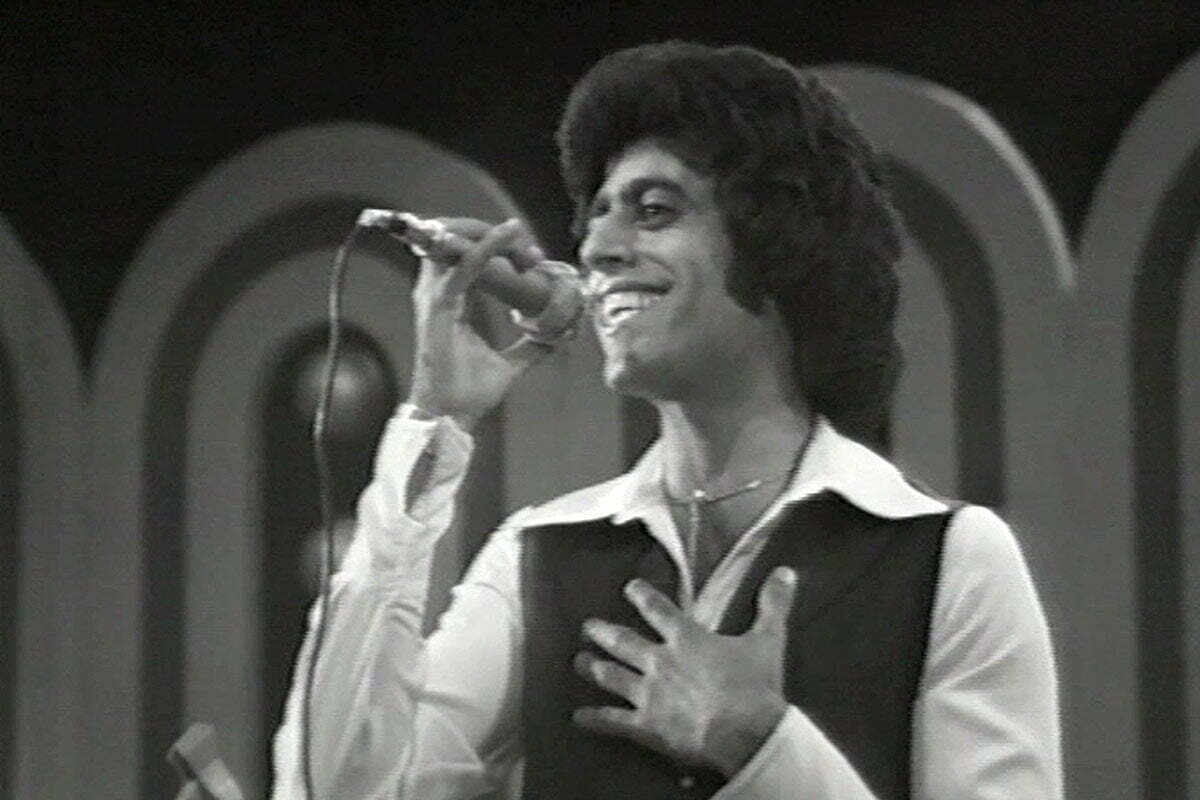
The Founding Charter of Binyanei Ha'uma - ICC Jerusalem
ICC Jerusalem – Binyanei Ha’uma is at the same time both a national and a popular enterprise. This nature of the institution finds prominent expression in the signing ceremony for the Founding Charter of ICC Jerusalem which was held on the 7th of Shvat, 5710 (January 25, 1950) at a ceremonial gathering held by the full Executive Board of the Jewish Agency. Leaders of that generation and public figures in Israel signed the document at this ceremony. People who struggled alongside Herzl stood next to people who fought in the War of Independence and together signed the renewed covenant between Jerusalem and the People of Israel. The spirit of the ICC Jerusalem enterprise is reflected in the names of those who signed the Founding Charter: the President, the Prime Minister, and his ministers, members of the Jewish Agency Executive Board, members of the Knesset, heads of the national funds and dozens of representatives from the founding settlements. The speakers in that event expounded on the importance of this great enterprise – experiencing the vision and the magnitude of the fact of ICC Jerusalem. (From ICC Jerusalem – Binyanei Ha’uma, 1950, issued by the Binyanei Ha’uma Association)
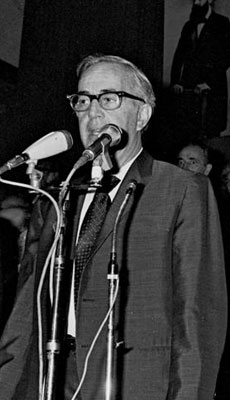
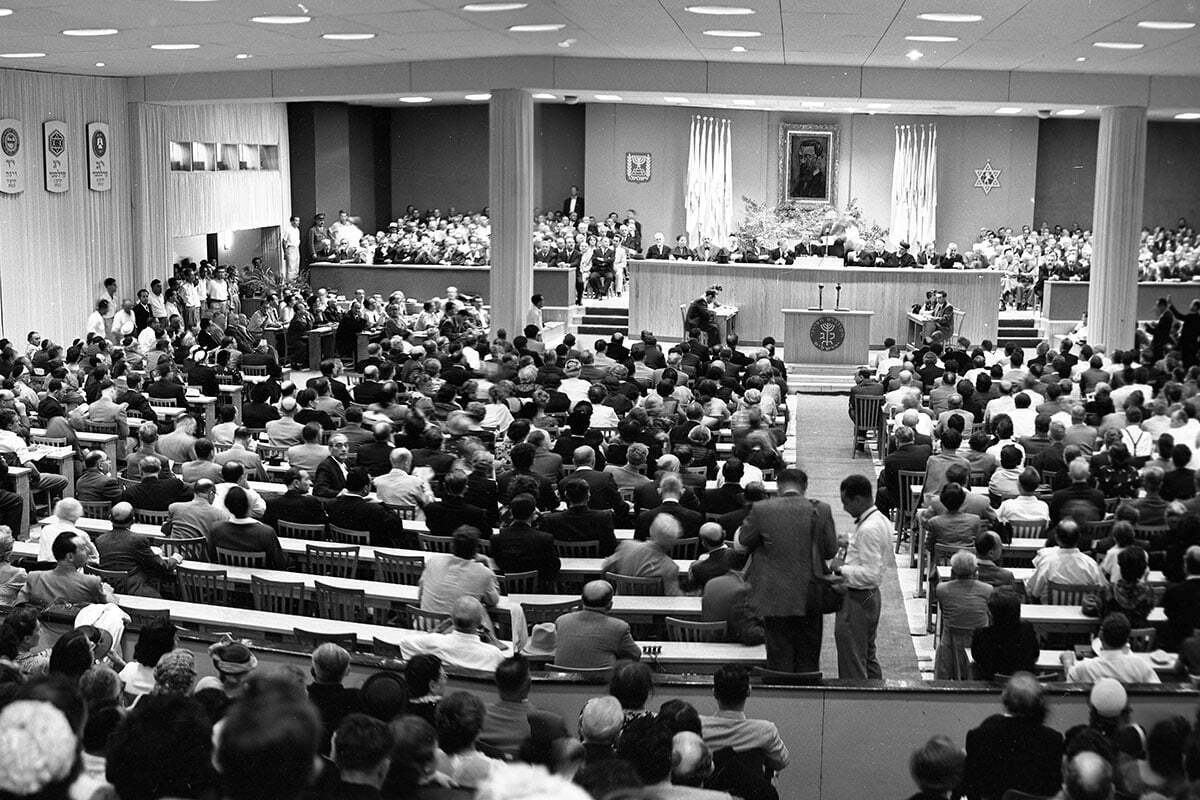
Signatories on the Founding Charter
1. Chaim Weizmann, 1874-1952, President of the State of Israel
Chaim Weizmann was born in Belarus in 1874. He completed his doctorate studies in chemistry, served as a delegate to the Zionist congresses, influenced the publication of the Balfour Declaration, led the “Delegates Committee”, was among the founders of the Hebrew University, served as President of the World Zionist Federation and founded the Weizmann Institute. He was the first President of the State of Israel. He passed away in 1952.
Excerpt of his remarks during the signing ceremony of the Founding Charter of ICC Jerusalem – Binyanei Ha’uma:
“Today we are signing the charter for the cornerstone of the Zionist Congress building in Jerusalem. This is a great event in our lives. Seemingly, we have not been lacking in days like these, since the founding of our state, great and important days. However, building a permanent seat for the Zionist Congress in Jerusalem is no light matter. Just as we are witnesses to changes of the face of the land from a wilderness to an inhabited land, we will also be privileged to make the dispersed and separated tribes of Israel into a single, integrated and functioning nation.”
2. David Ben-Gurion, 1886-1973, Prime Minister
David Ben-Gurion was born in Poland in 1886. He came to Israel when he was 20 and was expelled from it by the Turks when he was 29. He was recruited into the Jewish Brigade in the British Army. Ben-Gurion was one of the founders of the Ahdut Ha’avoda (the Labor Unity Party). He served as the Secretary-General of the General Federation of Jewish Labor. He was one of the founders of Mapai – the Workers Party of Eretz Israel – and served as Chairman of the Jewish Agency Executive Board. He declared the establishment of the State of Israel. He was the first Prime Minister of the State of Israel and its Minister of Defense. He later founded the RAFI Party – the Israeli Workers List. He passed away in 1973.
Excerpt of his remarks during the signing ceremony of the Founding Charter of ICC Jerusalem – Binyanei Ha’uma:
“With the establishment of the State of Israel, Jerusalem has been made its capital. Jerusalem is not merely the capital of the state, but rather was and will be the capital of the Hebrew nation. Jerusalem under Israel’s sovereignty will serve as a spiritual, scientific, and Torah center, for those seeking the good and justice of all Israel throughout the world. The capital of Israel will, due to the place it holds in Jewish and world history, hold within it Jewish and world conferences and will become a global center for justice and peace in the world.”
3. Berl Locker, 1887-1992, Chairman, Jewish Agency in Jerusalem
Berl Locker was born in Galicia in 1887. He was a member of the Poelei Zion Party and later a member of the Jewish Agency Executive Board. He came to Israel in 1936 and served as a political advisor of the Jewish Agency Executive.
He served as Chairman of the Jewish Agency from 1948 to 1956, as Secretary-General of the Histadrut Labor Federation and as Chairman of the Zionist Workers Council. He was awarded the title of “Esteemed Citizen of Jerusalem”. He passed away in 1972.
4. Yitzchak Isaac Halevi Herzog, 1888-1959, Chief Rabbi of Israel
Yitzchak Isaac Halevi Herzog was born in Poland in 1888 and moved in his youth to England. He was ordained by the rabbinate, studied mathematics and classic and Semitic languages, and received a doctorate in literature. He served as the Chief Rabbi of the Jews of Ireland. He worked to save Jews during the Second World War and to save children who survived the Holocaust. He served as the Chief Rabbi of the Land of Israel and of the State of Israel. He was awarded the Israel Prize in Rabbinical literature. He passed away in 1959.
5. Ben-Zion Meir Hai Uziel, 1880-1953, The Rishon Le’zion
Ben-Zion Meir Hai Uziel was born in Jerusalem in 1880 and served as the Rabbi of the Sephardic community in Yafo. He served as the president of the Mizrachi movement. He was appointed Rabbi of the Saloniki community and worked to disseminate the Hebrew language and Zionism. He served as the first Sephardic Chief Rabbi of Tel Aviv. He served as a member of the Zionist National Committee. He served as the Chief Rabbi and Rishon Le’zion of the Land of Israel and later of the State of Israel. He passed away in 1953.
6. Moshe Smoira, 1888-1961, President of the Supreme Court of Israel
Moshe Smoira was born in Germany in 1888 and studied Hebrew in his youth. He served in the German Army and received a doctorate in law. He came to Israel in 1920. Served as chairman of the Zionist Federation Court, as a member of the Mapai Party and one of the first five judges in the State of Israel. He served as the first President of the Supreme Court. He passed away in 1961.
7. Zeev Gold, 1889-1956, Head of the Jerusalem Development Department of the Jewish Agency, Member of ICC Jerusalem’s Executive Committee
Zeev Gold was born in Poland in 1889 and immigrated to the United States. He served as a community Rabbi in Chicago, San Francisco, and New York. He served as the President of the Torah Vodaath Yeshiva. He served as a member of the World Jewish Congress Executive Board and Honorary Chairman of the Jewish National Fund in the United States. He participated in Zionist congresses and was a member of the Zionist Workers Council. He served as a member of the Jewish Agency Executive Board and headed the Jerusalem Development Department. He was president of the Mizrachi Movement in Israel and was one of the signers of the Declaration of Independence. He passed away in 1956.
Excerpt of his remarks during the signing ceremony of the Founding Charter of ICC Jerusalem – Binyanei Ha’uma:
“Binyanei Ha’uma in Jerusalem, the holy city, will become the center of the new Jerusalem and a bridge between Israel and the Jewish people in the Diaspora. This building will gather together the scientists of our day and the greats of Torah study, wisdom and arts from all countries in which they are dispersed. We are now placing this cornerstone in order to realize grand plans intended to abundantly enrich our capital and bring spiritual and material benefit to the city, to the country and to Judaism as a whole.”
8. Nahum Goldmann, 1895-1982, Chairman, Jewish Agency in New York
Nahum Goldmann was born in Russia in 1895 and immigrated to Germany where he studied law and philosophy. He founded the German-Jewish Encyclopedia and the Encyclopedia Judaica. He served as a representative of the Zionist Federation to the League of Nations in Switzerland. He moved to New York, joining the Jewish Emergency Committee and served as a representative of the Jewish Agency. He was among the organizers of the World Zionist Congress and served as its President. He developed the idea of Beit Hatfutsot, the Diaspora Museum of the Jewish People. He passed away in 1982.
9. Yosef Sprinzak, 1885-1959. Speaker of the Knesset, Chairman of the Zionist Executive Committee
Yosef Sprinzak was born in Moscow in 1885 and was a member of the Russian Central Committee of “Zionists for Zion”. He wrote for Hebrew and Yiddish newspapers in Poland. He was among the founders of the Tze’irei Zion (Zionist Youth) in Russia and served as a delegate to the Zionist congresses. He immigrated to Israel in 1910 and served as the Secretary to the Hapoel Hatza’ir (Young Worker) movement and later as its head and was among the founders of the Workers Federation and Mapai. He served as a member of the Zionist Executive in Jerusalem, as the Secretary-General of the Histadrut and as Chairman of the Zionist General Council. He served as the first Speaker of the Knesset and following the death of Chaim Weizmann, served as Acting President of the state. He passed away in 1959.
Excerpt of his remarks during the signing ceremony of the Founding Charter of ICC Jerusalem – Binyanei Ha’uma:
“Three generations ago, the Hebrew people decided in a definitive and final manner to cease being strangers in a strange land. In order to rally the nation and to bring this decision to realization, Herzl established a home for convening the will of the people – the Zionist Congress. The construction of Binyanei Ha’uma will allow us to also compensate all those peoples that treated us with hospitality and we would be happy if there would also be conventions of science and global peace here.”
10. Avraham Granot, 1890-1962, Chairman of the Board of Directors of the Jewish National Fund
Member of ICC Jerusalem’s Executive Committee
Avraham Granot was born in Serbia in 1890. He studied law and economics in Switzerland and obtained a doctorate in law. He came to Israel in 1924 and worked together with Menachem Ussishkin. He served as a member of the People’s Council and was among the signers of the Declaration of Independence. He served as Chairman of the Jewish National Fund and was Chairman of the Board of Directors of the Mekorot Water Company. He also served as a member of Knesset. He passed away in 1962.
Excerpt of his remarks during the signing ceremony of the Founding Charter of ICC Jerusalem – Binyanei Ha’uma:
“The Jewish National Fund, which is one of the first creations of the Zionist Congress, has great satisfaction in lending a hand to the construction of this building, the first of several splendid buildings that will be constructed on the people’s land at the hub of Israel’s capital, within its city, the city of King David. The JNF acquired this spacious area and has placed it at the disposal of this enterprise. It is understood and it is clear that this building, which symbolizes the continued broad-based and blessed activity of the Zionist movement, must stand on land purchased by the people and for the entire people.”
11. Daniel Auster, 1893-1963, Mayor of Jerusalem
Chairman of the Jerusalem Committee of ICC Jerusalem – Binyanei Ha’uma Association
Daniel Auster was born in Galicia in 1893, studied law at the University of Vienna and immigrated to Israel in 1914. He served as the Secretary of the Legal Unit of the Delegates Committee and compiled a book of regulations for Hebrew courts. He was selected to the first representatives’ assembly on behalf of the Hapoel Hatza’ir Party. He was among the founders of the neighborhood of Rehavia and a member of the Jerusalem City Council. He served on the Board of Governors of the Jewish National Fund and was a member of the Temporary State Committee and was included among the signers of the Declaration of Independence. He was selected as the first Mayor of Jerusalem after the establishment of the state. He passed away in 1963.
Excerpt of his remarks during the signing ceremony of the Founding Charter of ICC Jerusalem – Binyanei Ha’uma:
“As long as Jews remain in the Diaspora, Israel will need them, and their existence there will be nothing without their eyes looking towards Zion and their hearts and souls directed to Israel. The City of Jerusalem and its residents extend blessings to the founders of this enterprise within greater Jerusalem. We are able to appreciate the magnitude of the deed and the courage, wisdom, and strength required to take on the execution of this sacred work. We are aware of the value of the general encouragement that this enterprise lends to Jerusalem.”
12. Alexander (Ezer) Yevzarov, 1894-1973, Executive Manager of ICC Jerusalem – Binyanei Ha’uma
Alexander Yevzarov was born in Ukraine in 1894 and studied law at the University of St. Petersburg where he edited a Zionist student newspaper. During the Russian Revolution, he escaped to China and established the Zionist Federation there. In 1921, he arrived in Israel and took part in the construction of the Haifa-Jeddah Highway. In the 1920s, he began to organize exhibitions where industrial products from the Land of Israel were presented. He established the “Commercial and Industrial” Economic Development Company and the “Levant Fairs Company”, which organized a large fair in the Land of Israel. Upon the establishment of the state, he moved to Jerusalem and began construction of Binyanei Ha’uma, which continued for nine years. He established the “International Club of Hebrew Literature” that exported Hebrew literature to communities of the Diaspora. He headed the “Tourism Center” and compiled and edited an essay – “Katzir” – on the history of Zionism in Russia. He passed away in 1973.
13. Siegfried Moses, 1887-1974, State Comptroller
Siegfried Moses was born in Germany in 1887, studied law and economics and was active in the German Zionist Federation and served as its chairman. He arrived in Israel in 1937 and was among the founders of the Leo Baeck Institute in Jerusalem for the study of German Jewish heritage. After the establishment of the state, he was appointed Comptroller and published the first Comptroller’s report in 1950. He passed away in 1974.
14. Henry Morgenthau Jr., 1891-1967
President of the United Jewish Appeal in the United States
Henry Morgenthau was born in 1891 in the United States and served as US Secretary of the Treasury during the administration of Franklin Delano Roosevelt. He helped shape and finance the New Deal Program, which helped extract the United States from the Great Depression. He served a central role in American foreign policy. After his resignation from his position with the administration, he directed most of his activities toward the benefit of the Jewish people. He was the President of the Jewish Appeal in the United States and among the founders of the Israel Bonds Program. He passed away in 1967.
15. Arye Shenkar, 1887-1859, President of the Industrialists Association
Arye Shenkar was born in 1897 in Ukraine and was one of the heads of the Hovavei Zion movement there. He immigrated to Israel in 1924 during the Fourth Aliyah and was one of the pioneers of the textile industry in Israel. He purchased the Lodzia factory, established the Industrialists Association of Israel and served as its president. He passed away in 1959.
16. Simcha Assaf (Ossovsky), 1889-1953, Rector of Hebrew University
Simcha Assaf was born in Russia in 1889 and served as the head of a yeshiva in Odessa, immigrating to Israel in 1921. Assaf did not get a formal education but was an expert in legal theory. He served as a teacher at the Teachers Seminary of the Mizrachi movement in Jerusalem. When the Hebrew University was founded in 1925, he served as a lecturer on the literature of the Geonim and Rabbinic literature. He was appointed as a judge to the Supreme Court and served as rector of THE Hebrew University. He passed away in 1953.
